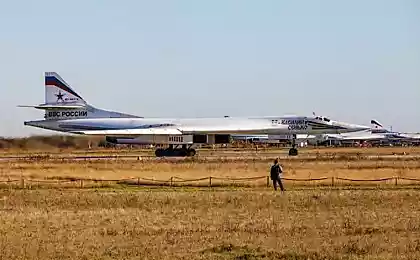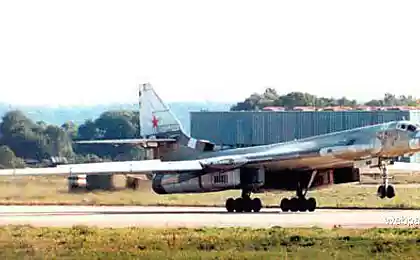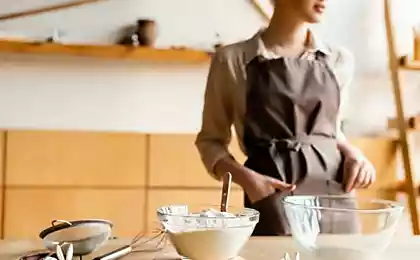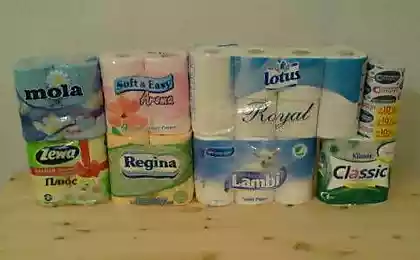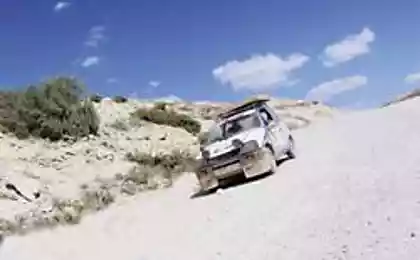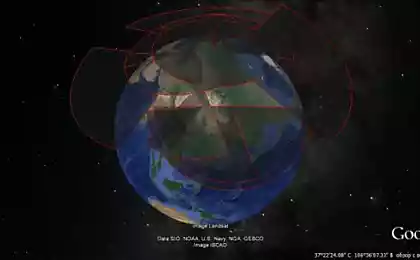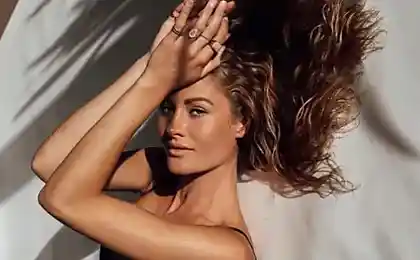693
Tu 160
15 ph + text.
I tried to summarize the info, but this airplane can talk endlessly!
In the 1960s, the Soviet Union broke forward in the area of strategic missile weapons [at the same time, the United States relied on the strategic aviation. The policy pursued by Nikita Khrushchev led to the fact that by the early 1970s, the Soviet Union possessed a powerful system of a nuclear attack, but strategic aviation had at his disposal only subsonic Tu-95 and M-4, unable to overcome the defense system of NATO at the time.
It is believed that the impetus for the development of the new Soviet bomber was the US decision to develop the project AMSA (Advanced Manned Strategic Aircraft) the latest strategic bomber - the future B-1. In 1967 the Council of Ministers of the USSR decided to begin work on a new multi-mode strategic intercontinental aircraft.

2.
For the future of the aircraft must meet the following basic requirements:
• flight range at speeds 3200-3500 km / h at an altitude of 18,000 meters - in the range of 11-13 thousand. Km;
• distance to subsonic flight at a height and land - 16-18 and 11-13 thousand kilometers, respectively;
• the aircraft was approaching the goal at cruising subsonic speed and overcome enemy air defenses - in supersonic high-altitude flight or on the ground at the cruising speed;
• the total mass of the payload - up to 45 tons.

3.
To work on a new bomber Sukhoi Design Bureau started and myasishchev. Tupolev because of the heavy workload involved not bylo.K top 70, both the OKW prepared their projects - chetyrёhdvigatelny aircraft with variable sweep wing. At the same time, despite some similarities, they used different schemes.
After the Air Force in 1969, introduced new tactical and technical requirements for the prospective strategic multi-mode aircraft, it has also begun to develop a Tupolev. It had a rich experience in solving problems of supersonic flight, resulting in the development and production of the world's first passenger supersonic Tu-144, including experience in the design of structures with long service life under conditions of supersonic flight, the development of the thermal protection of the airframe of the aircraft, and so on. D. < br />
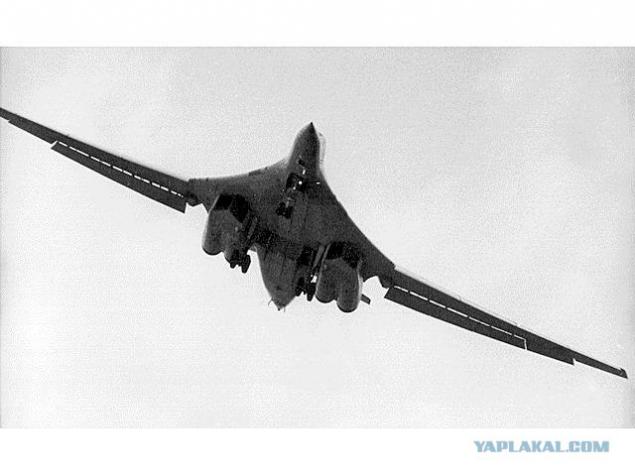
4.
In 1972, after consideration of the three projects ("article 200" Sukhoi Design Bureau, M-18 myasishchev and "article 160" Tupolev) the best was recognized scheme of the Sukhoi Design Bureau, but since it was occupied by the development of the Su-27, all the materials for further carry out work it was decided to transfer the Tupolev.
While working on the latest versions of integrated configurations aircraft T-4M, the developers came to the conclusion that the option of satisfying the above conditions, corresponds to the aerodynamic configuration of an integrated circuit of the "flying wing", but part of the wing is relatively small area should be variable in flight sweep ( ie turning the console).

5.
Such an arrangement (numbered "2B") was developed in August 1970 by LI Bondarenko, head of the department approved general types of Sukhoi Design Bureau OS Samoilovich, main designer NS Chernyakov and general aircraft designer Sukhoi Design Bureau and served as the basis for further development of preliminary design.
It was obtained by extremely high aerodynamic quality design value (17, 5) at a speed corresponding to M = 0, 8, and at a speed corresponding to M = 3, 0, 7, the coefficient is equal to 3. When a new "integrated" arrangement was also solved the problem of elastic deformation of the wing. Small area of the wing along with the hard carrying fuselage ensured the possibility of flying at high speeds near the ground.
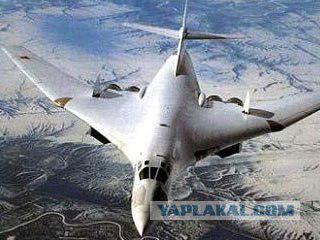
6.
Thus, the initial draft of the "Tupolev" strategic missile submitted OKB in the early 70s to the competition preliminary designs have been developed for the assembly scheme of the Tu-144 as good as its further development, taking into account a new target destination. Draft aircraft, compared with passenger airliner Tu-144 in a more central part of the integration of the airframe and the introduction of intensive weapons bays in the fuselage.
After selecting a layout scheme of aircraft design bureau forces concentrated on working out the specific elements of the aircraft and complex.
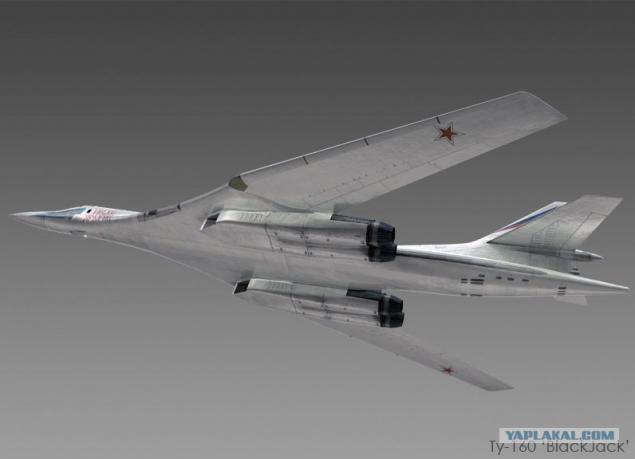
7.
June 26, 1974 the Resolution of the Council of Ministers, according to which the OKB. Tupolev was entrusted to develop a strategic multi-submarine bomber Tu-160 with four engines NK-32. Another "clarify" Government Regulation ╧1040-348 published December 19, 1975. These decrees were asked basic tactical and technical characteristics of the aircraft. The practical range with a combat load of 9,000 kg (ie, with two cruise missiles X-45) at a subsonic cruising flight was supposed to be 14000-16000 km range of the composite profile, including the section of track in the 2000 km at low altitude ( 50-200 m) or when flying at supersonic speed - 12000-13000 km, the maximum speed was set at a height in 2300-2500 km / h and a maximum speed when flying at low vysote- 1000 km / h. Service ceiling was on assignment at least 18,000-20,000 m. The normal weight of combat load - 9000 kg. maximum - 40000 kg. It was assumed that the Missiles was used in the following versions:
• 2 Kh-45M;
• 24 Kh-15 or 10-12 Kh-15M;
• 10-12 Kh-55 missiles.
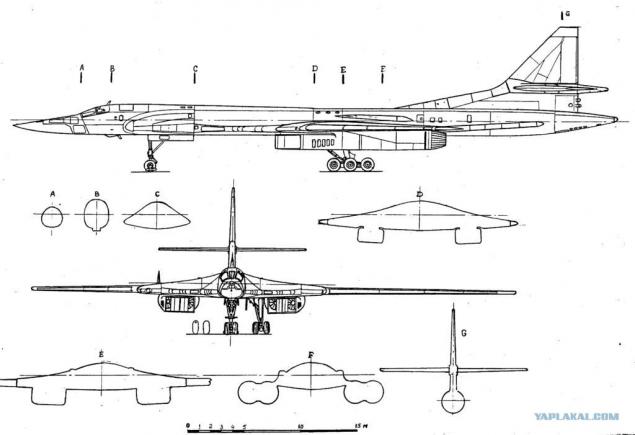
8.
Bomber was adopted to ensure the use of conventional and nuclear svobodnopadayuschie bombs, air bombs with laser and television guidance systems.
Despite the rejection of the direct development schemes of the Tu-144, some used it constructively and technological solutions have been used on the Tu-160. These include elements of integrated aerodynamic design, bringing together fuselage and wing naplyvnuyu part in a single unit. This arrangement decided three challenges at once - to ensure a high weight perfection, improved load-bearing properties and has enabled, thanks to the large internal volume to place a significant number of the combat load and fuel. As a result, when close to the dimensions of the Tu-95 Tu-160 was 50% heavier.
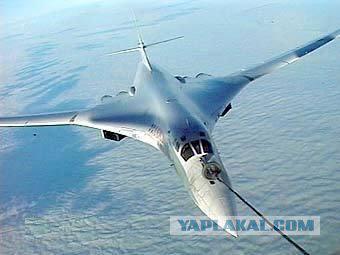
9.
For the production units of the aircraft has been designed and manufactured a range of technological equipment, which included a line of large-sized machine tools, Pulling presses, hardening, welding and heat-treatable furnaces and plants, many of which were unique (such as ELU-24 and UVN-4500m) . It was possible to master the production of welded assemblies, together with the center-pivot wing panels.

10.
After the completion of major works by the summer of 1980 the first flying prototype of the Tu-160 ("70-01" or "flight 01") was moved from Moscow to Zhukovsky, where ZHLI and DB (Zhukovsky flight test and development base) MMZ "Experience "finished its assembly. August 18, 1981 a huge unpainted car rolled out onto the tarmac of the airfield for castings, ground testing systems and equipment, which began on 22 October. Final assembly of the prototype was completed in Zhukovsky in January 1981. For nearly 10 months (until November 1981) continued development and testing of various systems. All the ground work and flight tests were conducted under the supervision of the Chief ZHLI and DB V.T.Klimova and his deputy V.G.Mihaylova. The flight tests involved test pilots EDO (MMZ "Experience") and MAP - B.I.Veremey, S.G.Agapov, V.V.Pavlov, V.N.Matveev and V.A.Dralin and as navigators and M.M.Kozel A.V.Eremenko, with methodological and organizational support of leading teams of engineers led by A.K.Yashukova. As adopted in ZHLI and DB test procedure, each instance of the aircraft was assigned to the leading pilot and lead engineer. At various stages of flight testing complex provides superior LIC (flight test facility) M.V.Ulyanov leading engineers R.A.Engulatov, A.P.Gusev and V.A.Naumov. Coordinate the preparation of the aircraft for flight and operational guidance to emerging defects provided leading engineers OKB V.V.Babakov, E.L.Kornilov, V.V.Tereshin, E.A.Aleshin and others. Much work on improvement of engines NK-32 and operational refinements of the power plant was completed leading engineer of OKB Yu.S.Gorbatenko.

11.
NATO machine assigned preliminary designation «RAM-P», later the plane was given a new code name - «Blackjack». Since then, the US intelligence service space continuously followed the trials of the new Soviet bomber. His appearance prompted the US government to speeding up work on the aircraft B-1B and accelerated its serial production.
Equipment. The Tu-160 is equipped with the most modern flight-navigation and radio equipment, including a specially designed set of weapons control. The equipment provides automatic flight and combat use of the whole range of weapons. It consists of a number of systems and sensors that enable engaging surface targets, regardless of the time of day and weather conditions in the region. Along with many indicators electromechanical widely used indicators in the form of electronic display.

12.
At the Tu-160 is set to duplicate the inertial navigation system, celestial navigation, satellite navigation, multi-channel digital communication system and advanced electronic warfare system, detects enemy radar in a wide range of powerful formulation of active and passive jamming.
On board there is a large number of computers digital devices. The total number of digital signal processors, and autonomous network structure ensuring operation of the systems and equipment exceeds 100 units. Each workstation is equipped with a specialized crew onboard digital computer.
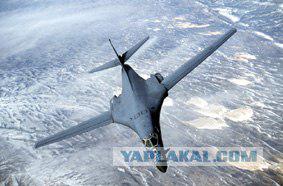
13.
Sighting and navigation system (PrNK) "Review-K" is intended for the detection and identification at a great distance of land and sea targets, management of their destruction, as well as to solve the problems of navigation and piloting. PrNK basis of a multi-purpose navigation and sighting radar placed in the nose of the aircraft. There is also an optoelectronic bombsight OPB-15T, providing precision bombing by day and in low light. In the future, the aircraft can be equipped with a laser system illumination of ground targets, which applies to high altitudes corrected aerial bombs of various types.
On-board defense system (GER) "Baikal" can detect enemy air defenses, pinpoint their position to stifle noise of aircraft or put a veil of false targets. The tail cone are numerous containers with IR-traps and chaff. At the extreme rear of the fuselage set teplopelengator "Spark" which detects approaching from the rear hemisphere missiles and enemy aircraft. On the dashboard of pilots established standard electromechanical devices, similar to those used in other combat aircraft (such as the Tu-22M). The cabin is as simple as possible, while ensuring maximum comfort for the crew performing long flights.
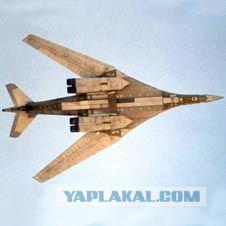
14.
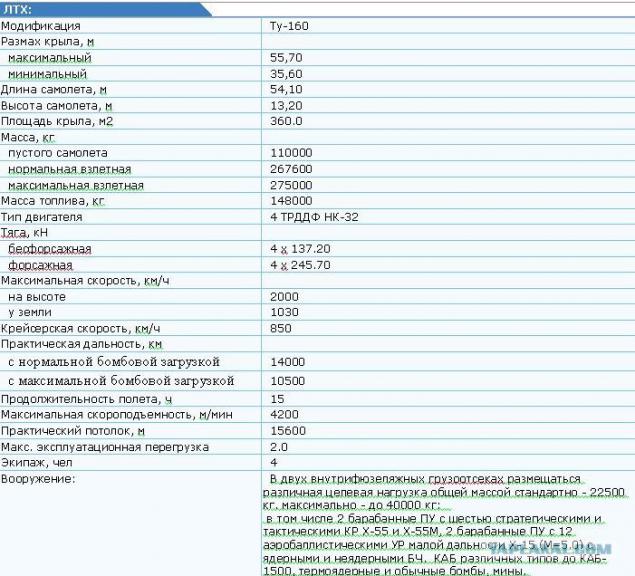
15.
Cruise missiles Tu-160 are capable of striking targets at a distance of more than two thousand kilometers.
"One hour of flight of the Tu-160, without the use of military costs 580,000 rubles - this is the most expensive aircraft of the Air Force" But it's worth it. Analogues of this machine does not exist in the world.
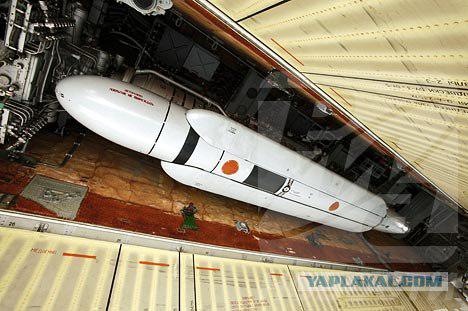
Source:
I tried to summarize the info, but this airplane can talk endlessly!
In the 1960s, the Soviet Union broke forward in the area of strategic missile weapons [at the same time, the United States relied on the strategic aviation. The policy pursued by Nikita Khrushchev led to the fact that by the early 1970s, the Soviet Union possessed a powerful system of a nuclear attack, but strategic aviation had at his disposal only subsonic Tu-95 and M-4, unable to overcome the defense system of NATO at the time.
It is believed that the impetus for the development of the new Soviet bomber was the US decision to develop the project AMSA (Advanced Manned Strategic Aircraft) the latest strategic bomber - the future B-1. In 1967 the Council of Ministers of the USSR decided to begin work on a new multi-mode strategic intercontinental aircraft.

2.
For the future of the aircraft must meet the following basic requirements:
• flight range at speeds 3200-3500 km / h at an altitude of 18,000 meters - in the range of 11-13 thousand. Km;
• distance to subsonic flight at a height and land - 16-18 and 11-13 thousand kilometers, respectively;
• the aircraft was approaching the goal at cruising subsonic speed and overcome enemy air defenses - in supersonic high-altitude flight or on the ground at the cruising speed;
• the total mass of the payload - up to 45 tons.

3.
To work on a new bomber Sukhoi Design Bureau started and myasishchev. Tupolev because of the heavy workload involved not bylo.K top 70, both the OKW prepared their projects - chetyrёhdvigatelny aircraft with variable sweep wing. At the same time, despite some similarities, they used different schemes.
After the Air Force in 1969, introduced new tactical and technical requirements for the prospective strategic multi-mode aircraft, it has also begun to develop a Tupolev. It had a rich experience in solving problems of supersonic flight, resulting in the development and production of the world's first passenger supersonic Tu-144, including experience in the design of structures with long service life under conditions of supersonic flight, the development of the thermal protection of the airframe of the aircraft, and so on. D. < br />

4.
In 1972, after consideration of the three projects ("article 200" Sukhoi Design Bureau, M-18 myasishchev and "article 160" Tupolev) the best was recognized scheme of the Sukhoi Design Bureau, but since it was occupied by the development of the Su-27, all the materials for further carry out work it was decided to transfer the Tupolev.
While working on the latest versions of integrated configurations aircraft T-4M, the developers came to the conclusion that the option of satisfying the above conditions, corresponds to the aerodynamic configuration of an integrated circuit of the "flying wing", but part of the wing is relatively small area should be variable in flight sweep ( ie turning the console).

5.
Such an arrangement (numbered "2B") was developed in August 1970 by LI Bondarenko, head of the department approved general types of Sukhoi Design Bureau OS Samoilovich, main designer NS Chernyakov and general aircraft designer Sukhoi Design Bureau and served as the basis for further development of preliminary design.
It was obtained by extremely high aerodynamic quality design value (17, 5) at a speed corresponding to M = 0, 8, and at a speed corresponding to M = 3, 0, 7, the coefficient is equal to 3. When a new "integrated" arrangement was also solved the problem of elastic deformation of the wing. Small area of the wing along with the hard carrying fuselage ensured the possibility of flying at high speeds near the ground.

6.
Thus, the initial draft of the "Tupolev" strategic missile submitted OKB in the early 70s to the competition preliminary designs have been developed for the assembly scheme of the Tu-144 as good as its further development, taking into account a new target destination. Draft aircraft, compared with passenger airliner Tu-144 in a more central part of the integration of the airframe and the introduction of intensive weapons bays in the fuselage.
After selecting a layout scheme of aircraft design bureau forces concentrated on working out the specific elements of the aircraft and complex.

7.
June 26, 1974 the Resolution of the Council of Ministers, according to which the OKB. Tupolev was entrusted to develop a strategic multi-submarine bomber Tu-160 with four engines NK-32. Another "clarify" Government Regulation ╧1040-348 published December 19, 1975. These decrees were asked basic tactical and technical characteristics of the aircraft. The practical range with a combat load of 9,000 kg (ie, with two cruise missiles X-45) at a subsonic cruising flight was supposed to be 14000-16000 km range of the composite profile, including the section of track in the 2000 km at low altitude ( 50-200 m) or when flying at supersonic speed - 12000-13000 km, the maximum speed was set at a height in 2300-2500 km / h and a maximum speed when flying at low vysote- 1000 km / h. Service ceiling was on assignment at least 18,000-20,000 m. The normal weight of combat load - 9000 kg. maximum - 40000 kg. It was assumed that the Missiles was used in the following versions:
• 2 Kh-45M;
• 24 Kh-15 or 10-12 Kh-15M;
• 10-12 Kh-55 missiles.

8.
Bomber was adopted to ensure the use of conventional and nuclear svobodnopadayuschie bombs, air bombs with laser and television guidance systems.
Despite the rejection of the direct development schemes of the Tu-144, some used it constructively and technological solutions have been used on the Tu-160. These include elements of integrated aerodynamic design, bringing together fuselage and wing naplyvnuyu part in a single unit. This arrangement decided three challenges at once - to ensure a high weight perfection, improved load-bearing properties and has enabled, thanks to the large internal volume to place a significant number of the combat load and fuel. As a result, when close to the dimensions of the Tu-95 Tu-160 was 50% heavier.

9.
For the production units of the aircraft has been designed and manufactured a range of technological equipment, which included a line of large-sized machine tools, Pulling presses, hardening, welding and heat-treatable furnaces and plants, many of which were unique (such as ELU-24 and UVN-4500m) . It was possible to master the production of welded assemblies, together with the center-pivot wing panels.

10.
After the completion of major works by the summer of 1980 the first flying prototype of the Tu-160 ("70-01" or "flight 01") was moved from Moscow to Zhukovsky, where ZHLI and DB (Zhukovsky flight test and development base) MMZ "Experience "finished its assembly. August 18, 1981 a huge unpainted car rolled out onto the tarmac of the airfield for castings, ground testing systems and equipment, which began on 22 October. Final assembly of the prototype was completed in Zhukovsky in January 1981. For nearly 10 months (until November 1981) continued development and testing of various systems. All the ground work and flight tests were conducted under the supervision of the Chief ZHLI and DB V.T.Klimova and his deputy V.G.Mihaylova. The flight tests involved test pilots EDO (MMZ "Experience") and MAP - B.I.Veremey, S.G.Agapov, V.V.Pavlov, V.N.Matveev and V.A.Dralin and as navigators and M.M.Kozel A.V.Eremenko, with methodological and organizational support of leading teams of engineers led by A.K.Yashukova. As adopted in ZHLI and DB test procedure, each instance of the aircraft was assigned to the leading pilot and lead engineer. At various stages of flight testing complex provides superior LIC (flight test facility) M.V.Ulyanov leading engineers R.A.Engulatov, A.P.Gusev and V.A.Naumov. Coordinate the preparation of the aircraft for flight and operational guidance to emerging defects provided leading engineers OKB V.V.Babakov, E.L.Kornilov, V.V.Tereshin, E.A.Aleshin and others. Much work on improvement of engines NK-32 and operational refinements of the power plant was completed leading engineer of OKB Yu.S.Gorbatenko.

11.
NATO machine assigned preliminary designation «RAM-P», later the plane was given a new code name - «Blackjack». Since then, the US intelligence service space continuously followed the trials of the new Soviet bomber. His appearance prompted the US government to speeding up work on the aircraft B-1B and accelerated its serial production.
Equipment. The Tu-160 is equipped with the most modern flight-navigation and radio equipment, including a specially designed set of weapons control. The equipment provides automatic flight and combat use of the whole range of weapons. It consists of a number of systems and sensors that enable engaging surface targets, regardless of the time of day and weather conditions in the region. Along with many indicators electromechanical widely used indicators in the form of electronic display.

12.
At the Tu-160 is set to duplicate the inertial navigation system, celestial navigation, satellite navigation, multi-channel digital communication system and advanced electronic warfare system, detects enemy radar in a wide range of powerful formulation of active and passive jamming.
On board there is a large number of computers digital devices. The total number of digital signal processors, and autonomous network structure ensuring operation of the systems and equipment exceeds 100 units. Each workstation is equipped with a specialized crew onboard digital computer.

13.
Sighting and navigation system (PrNK) "Review-K" is intended for the detection and identification at a great distance of land and sea targets, management of their destruction, as well as to solve the problems of navigation and piloting. PrNK basis of a multi-purpose navigation and sighting radar placed in the nose of the aircraft. There is also an optoelectronic bombsight OPB-15T, providing precision bombing by day and in low light. In the future, the aircraft can be equipped with a laser system illumination of ground targets, which applies to high altitudes corrected aerial bombs of various types.
On-board defense system (GER) "Baikal" can detect enemy air defenses, pinpoint their position to stifle noise of aircraft or put a veil of false targets. The tail cone are numerous containers with IR-traps and chaff. At the extreme rear of the fuselage set teplopelengator "Spark" which detects approaching from the rear hemisphere missiles and enemy aircraft. On the dashboard of pilots established standard electromechanical devices, similar to those used in other combat aircraft (such as the Tu-22M). The cabin is as simple as possible, while ensuring maximum comfort for the crew performing long flights.

14.

15.
Cruise missiles Tu-160 are capable of striking targets at a distance of more than two thousand kilometers.
"One hour of flight of the Tu-160, without the use of military costs 580,000 rubles - this is the most expensive aircraft of the Air Force" But it's worth it. Analogues of this machine does not exist in the world.

Source:
